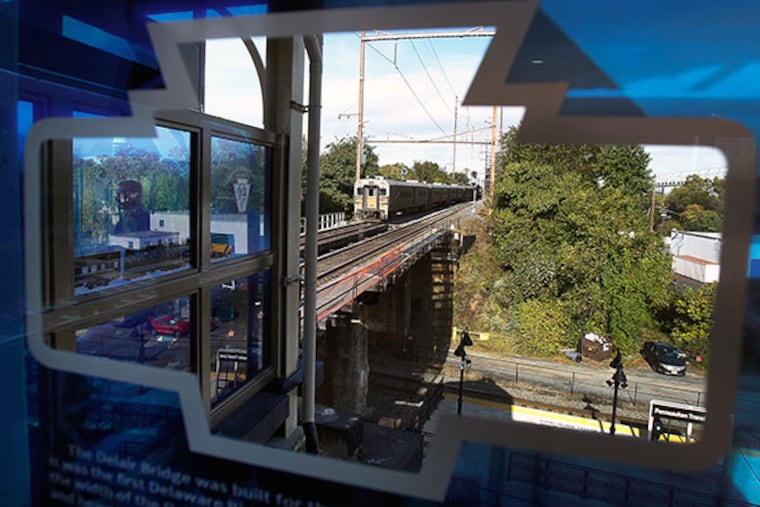New station links two South Jersey rail lines
The $40 million Pennsauken Transit Center that officially opened Monday morning, linking NJ Transit's River Line to its Atlantic City Rail Line, offers more than a quick trip to the Jersey Shore.

The $40 million Pennsauken Transit Center that officially opened Monday morning, linking NJ Transit's River Line to its Atlantic City Rail Line, offers more than a quick trip to the Jersey Shore.
The 200-foot platform and three-level canopy have a glass facade and sculpture that takes commuters back in time by celebrating notable women from throughout Pennsauken's history. They also pay tribute to the American Indians whose farming techniques brought considerable profit to South Jersey's early settlers, said the artist, J. Kenneth Leap.
Leap was among dignitaries and dozens involved in the project who attended a ribbon-cutting to mark the opening of the transit center, which had been in the making since at least 2007.
Leap's work is called My Jersey Girl, inspired by a 19th-century poem by physician J. Dunbar Hylton:
I met her 'neath the willow tree,
Where Pennsauken waters flow;
I smiled at her, she blushed at me,
In ways that bashful lovers know. . . .
Leap focused not on the men who built the township, but the women who gave Pennsauken its "soul and spirit," he said.
The main image is a paper-cut profile of a woman similar to ones created in the 17th century. The subject of the love poem is unknown. Leap said her identity is for commuters to ponder and imagine.
Leap's images are painted film between glass, illuminated by natural lighting during the day.
"That's Grandma," said Fabiene Hunter Brown as she laughed and hugged relatives when they saw the artwork for the first time.
Brown, a retired Cinnaminson music teacher, grew up in Pennsauken. On Monday, she took pictures of her cousin Brenda White Hailey, whose image appeared in another work. The painting was created from a photo taken when Hailey was crowned Miss New Jersey USA in 1971.
Hailey, also a retired teacher, taught in Pennsauken for 36 years. Their grandparents Mary and Clarence Hunter bought the Dew Drop Inn in 1936, on Derousse Avenue near where the transit center now stands. They and their children employed many local residents until the night spot closed in 1979.
The family knew that Mary Hunter, born Carney, was among the women Leap considered as he researched Pennsauken with the help of a local historian. Until Monday, they did not know she had been selected.
As spectators admired the artwork, trains rolled through Pennsauken, picking up riders who now have direct transfers connecting to Trenton, Camden, Atlantic City, and 30th Street Station.
"I love to go to Atlantic City," said Philip Roberts of Trenton, who said he wanted to ride the light rail River Line on the first day connections started at Pennsauken. Before Monday, Roberts said, he took the River Line to Camden, where he caught a bus to the Shore.
Local politicians say the transportation center, off Derousse and west of River Road, will improve South Jersey's economy. In Pennsauken, several industries have plans to expand, and a 78-unit residential development has been approved. They also expect more commuters to use rail to get to a nursing school and cancer center opening in Camden. And they hope tourists will take advantage of easier access to Atlantic City.
"This is going to make this community take off," said State Senate President Stephen Sweeney (D., Gloucester), who grew up in Pennsauken. "Jobs, jobs, jobs. That's what matters."
U.S. Rep. Robert E. Andrews (D., N.J.) said plans for the transit center started in 2007, when the economy was strong. At groundbreaking in 2009, the housing bubble had burst, and the economy was in sharp decline.
In Camden, Burlington and Gloucester Counties, 30,000 people lost jobs between 2007 and 2009, Andrews said. Since then, 20,000 people are back at work.
"That's not enough," Andrews said, adding the only way to improve America's economy is to "dig out" with more jobs.
Local politicians credited Gov. Christie and U.S. Sen. Robert Menendez (D., N.J.) for bipartisan support in helping complete the project.
Among those at the ribbon-cutting were residents who pushed for the transit center long before 2007.
Jeffrey Marinoff, a vice chair of the South Jersey Transit Advisory Committee, uses transit every day. He has never owned a car, he said. Since the mid-1990s, he has urged officials to fund South Jersey transit projects.
"This is my baby," Marinoff said. "I am seeing a dream come true."
The station also is a stop on NJ Transit Bus Route 419, which connects Camden and Burlington.
The platform is covered with a 60-foot canopy along the River Line, and two 300-foot-long, high-level platforms have been built on each side of the elevated Atlantic City tracks, with stairs and elevators connecting the levels.
Parking for 280 vehicles is available in front of the station.
Officials said most of the project was paid for with $36 million from the federal stimulus. The River Line opened in 2004 and makes 21 stops in towns along the Delaware River.
856-779-3838 @BBBoyer